Robotic Process Automation (RPA) vs Intelligent Process Automation (IPA)
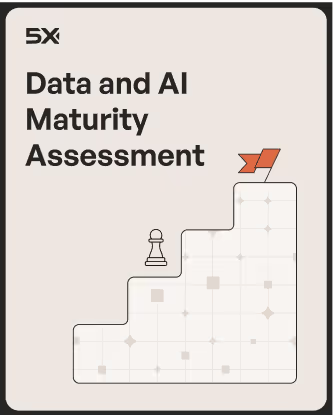


Table of Contents
TL; DR
TL;DR
- RPA automates rule-based tasks with bots that mimic human actions
- IPA combines RPA with AI to handle complex, changing, and unstructured processes
- RPA follows rules; IPA makes decisions and learns over time
- IPA delivers more scale, resilience, and long-term ROI
- Choose RPA for simple workflows; use IPA when decisions or data variety are involved
You build a bot to handle invoices. It works until one day, the format changes. Now the bot breaks, the process stalls, and your team is back to fixing things manually. That’s the limit of traditional robotic process automation (RPA). It’s great at doing what it’s told, but the second something shifts, it falls apart.
RPA follows a script. It clicks, copies, and pastes with robotic precision, but it doesn’t adapt. So when your business changes (which it always does), RPA can’t keep up. That’s why scaling RPA often means managing dozens of brittle bots, each one prone to breaking anytime a field moves or a rule changes.
This is where intelligent process automation (IPA) takes over. IPA adds AI to automation, letting it read, understand, and adapt on the fly. Instead of choking on a new invoice format, an IPA-powered bot can recognize patterns, extract data, and keep going. No rescue required.
This article will explore RPA vs. IPA in depth: what each term really means, how they differ, and why it matters for your business. By the end, you’ll see how adding intelligence to automation can transform those pesky broken bots into resilient digital workers. Let’s start by grounding ourselves in what RPA is (and isn’t), and then we’ll level up to IPA – and beyond.
What is Robotic Process Automation (RPA)?
Robotic Process Automation (RPA) is a technology that uses software “robots” or bots to emulate human actions in digital systems. In plain English, an RPA bot is a piece of software that you can program to click, type, and navigate computer applications just like a person would!
RPA is typically used to automate repetitive, rule-based tasks that were previously done manually. If a task involves the same steps every time (log in here, copy data there, move file to folder X, etc.), it’s a prime candidate for RPA.
Think of tasks like:
- Data entry: Reading fields from one system and inputting into another (without errors or typos)
- Invoice processing: Matching purchase orders to invoices in an ERP system
- Employee onboarding: Setting up accounts across multiple systems when a new hire joins
Key benefits of RPA include speed and consistency: bots don’t get tired or bored, and they don’t introduce the kind of random errors humans might when fatigued. As a result, companies often see processes accelerated and error rates plummet when they deploy RPA.
For example, an HR department might cut down the new employee setup time from days to minutes by letting an RPA bot handle account creations and paperwork.
However, it’s crucial to note what RPA does not do. RPA does not “think” or understand meaning. It’s not AI; in fact, industry analysts remind us that despite the name “robotic,” classic RPA has “no real intelligence in a true sense.”
Imagine an RPA bot that processes emails to update support tickets. If it’s programmed with specific keywords or formats (“if subject contains ‘Reset password’ do A, if ‘Cannot login’ do B”), it will work for those known cases. But the moment an email comes in phrased in a novel way, the RPA bot won’t grasp it.
What is Intelligent Process Automation (IPA)?
Intelligent Process Automation (IPA) is the natural evolution of automation that occurs when you take RPA and add artificial intelligence into the mix. If RPA is a digital worker that can do exactly what you teach it, IPA is a digital worker that can learn, reason, and make some decisions on its own.
In essence, IPA = RPA + AI + more.
It’s sometimes also called intelligent automation or cognitive automation. The key idea is that automation isn’t limited to predefined rules anymore; it can incorporate machine learning models, natural language processing, and other AI technologies to handle tasks that involve understanding and adaptation.
Let’s break down the components of IPA:
- It still has RPA at its core (bots executing tasks)
- It incorporates AI/ML models. Example: a machine learning model that can classify images or predict an outcome
- It uses technologies like optical character recognition (OCR) to read unstructured text (say, a PDF invoice or a handwritten form), and natural language processing (NLP) to understand human language from emails or chat messages
- It may involve workflow orchestration tools (sometimes called Digital Process Automation or BPM) to manage end-to-end processes and coordinate between bots, humans, and AI decisions
Also read: Building Agentic AI: Definition, Features, Benefits, and Frameworks
Use cases for IPA
For instance, consider a customer service scenario: a pure RPA solution might automate data entry across systems when processing a return, but it won’t talk to the customer. An IPA solution, on the other hand, could include a chatbot that converses with the customer to gather info (using NLP to understand their responses), then trigger RPA bots to perform the refunds or updates in backend systems, and maybe even use a machine learning model to decide if the customer is eligible for a loyalty offer.
Another example: Intelligent Document Processing (IDP). Say a mortgage company receives thousands of documents: pay stubs, W-2s, bank statements, each in different formats. An RPA approach could be used if every document was the same template – but they’re not.
An IPA approach leverages AI: use OCR to extract text, a machine learning model to classify document types, and perhaps another model to locate key data points (income, account balances) on each page. The IPA system then uses RPA bots to enter those extracted details into the mortgage processing system. Here, IPA handles the variability (different document layouts, types) by learning what to look for on each type, something pure RPA could never do reliably.
The difference between RPA and IPA
At a high level, the difference between RPA and IPA boils down to one word: intelligence. RPA is fast and tireless, but dumb in the sense that it can’t handle anything it wasn’t explicitly told to do.
IPA is smart automation; it can reason and adapt.
To really understand the difference, see this example:
Suppose you run an e-commerce business with a returns process. In an RPA solution, you might deploy a bot to retrieve return requests from an email and enter them into your system, but if a customer’s email doesn’t exactly match the expected format, the bot might fail.
In an IPA solution, an AI model could read and interpret any customer email (understanding sentiment, urgency, etc.), another bot could check the order and inventory systems, and then the system could even decide an optimal resolution (refund, replace, escalate) based on business rules learned from past data. That entire sequence could happen without a human, even for slightly weird requests, because the AI adds interpretation where RPA alone wouldn’t cope.
Deepgram goes a step further. They aim to make interactions with machines feel as natural as talking to another person—and they’re not alone in striving for that.
“The new language model will allow consumers to have more human-like conversations with a ‘smarter and more conversational’ Alexa…speech‑to‑speech model to mimic human responses such as laughter.”
~ Lauren Sypniewski, Head of Data Operations, Deepgram
How Deepgram is making AI interaction colloquial
6 Benefits of automation in business processes
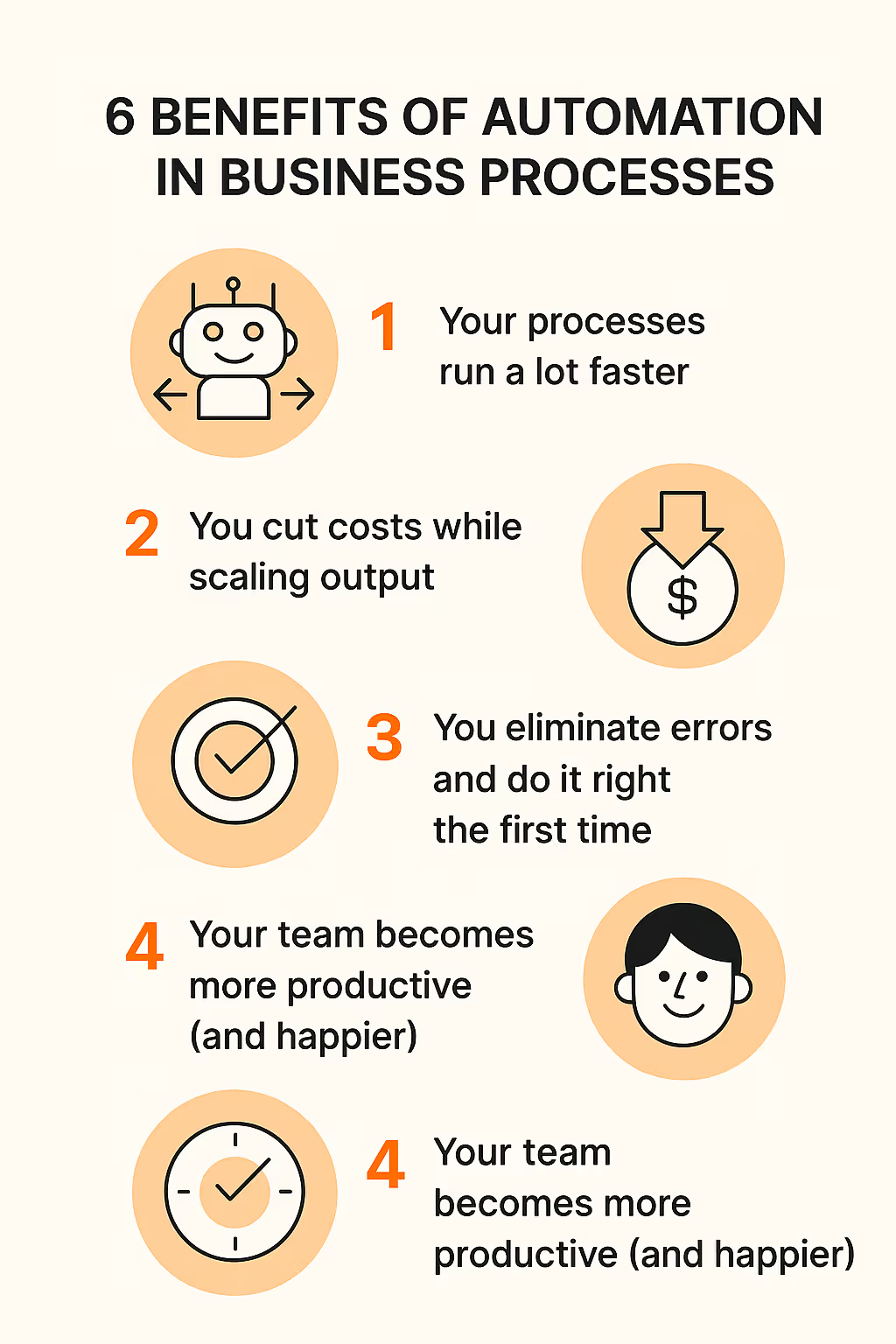
RPA and IPA don’t just eliminate repetitive work, they fix broken workflows. When done right, automation gives you faster execution, fewer errors, lower costs, and more room to scale. Here’s how it delivers across the board:
1. Your processes run a lot faster
Manual workflows are slow, repetitive, and filled with delays. Automation fixes that. A basic bot can process data in seconds, turning days of work into minutes. When you add intelligence, you also remove decision bottlenecks.
On average, automation cuts process cycle times by 50–60%, while low-code tools deliver new solutions 3–5X faster than traditional dev teams.
That means faster service, quicker decisions, and more capacity without adding headcount.
2. You cut costs while scaling output
Speed isn’t the only win. Automation also slashes costs. Tasks that took hours or entire teams now get done automatically, around the clock. And fewer errors means less rework and waste.
Cupbop automated reporting and inventory analysis, saving 300+ staff hours per month.
3. You eliminate errors and do it right the first time
Repetitive tasks lead to mistakes. Bots don’t make those mistakes. Automation reduces manual errors, and with IPA, you go beyond execution; the system can flag anomalies or compliance issues in real time.
4. Your team becomes more productive (and happier)
No one wants to spend their day copying data or manually updating reports. Automation takes those tasks off your team’s plate so they can focus on work that actually matters.
Instead of fixing spreadsheet errors, they’re analyzing trends. Instead of filling forms, they’re solving problems.
The result: a team that’s more motivated, more creative, and more valuable.
RPA vs. IPA: Which is best for your business?

The answer depends on your specific business processes, goals, and resources. It’s not always an either/or choice. In many cases, the path starts with RPA, evolves to IPA. Let’s discuss scenarios for each and how to decide the right fit.
Choose RPA for simplicity and quick wins
RPA’s relative simplicity also means it’s easier to pilot. You can start small with RPA, see the benefits, and expand. Many businesses do exactly this; they automate a handful of tasks (like form processing, or data reconciliation) with RPA, realize significant time savings, and then look to tackle more complex processes.
RPA is ideal when:
1. The process is well-defined and stable
For example, extracting data from one system and entering into another where the format never changes. If you have a legacy system with no API that requires manual data transfer, an RPA bot can reliably do that grunt work
2. The data involved is structured
Think of processes involving spreadsheets, forms, databases where the fields are consistent. If a human currently follows a clear rulebook without needing subjective judgment, RPA can probably handle it. A classic case is generating routine reports by pulling numbers from various systems; RPA can click through each system and compile the report, no AI needed.
3. Cost and speed of implementation are critical
RPA can often be deployed faster and cheaper than an AI-driven solution. You don’t need to gather and train models; you just configure the bot with the steps. This means if you’re looking for a quick ROI in a specific area, RPA might give you that faster.
For instance, if your accounts payable is backlogged, an RPA bot could be set up in a matter of weeks to clear the backlog by automating invoice entries. The quick win not only saves cost but can build momentum for automation in your company.
However, be mindful of RPA’s limits in making your decision. If you deploy RPA broadly in a dynamic environment, you may hit a maintenance burden. A large percentage of RPA implementations hit a scalability wall due to maintenance and lack of resilience (bots breaking often).
So, if you anticipate that a process will undergo frequent changes or involves a lot of exception paths, scaling pure RPA might become costly or frustrating. In those cases, jumping straight to or planning for IPA could be wiser.
Choose IPA for agility and complex processes
If your process is complex, variable, or strategic, IPA is likely the better choice despite requiring more investment. Opt for IPA when:
1. The process requires decision-making or judgment
For example, evaluating loan applications, triaging customer service tickets, diagnosing an IT incident. These require analyzing information and making a call. IPA can automate those decisions using AI models, whereas RPA cannot. If the quality or speed of those decisions is critical to your business (e.g., quicker loan approvals to beat competitors, consistent service triaging for better SLAs), IPA provides an edge.
2. The inputs or scenarios are unstructured or unpredictable
If you’re dealing with documents, images, free-form text, or rapidly changing data, IPA’s AI component is needed. For instance, in marketing, analyzing social media sentiment or pulling insights from customer emails can’t be done with RPA, but an NLP model as part of IPA can do it.
Similarly, if each instance of the process can follow multiple paths (like an insurance claim might be straightforward or suspicious or incomplete, each needing different handling), IPA’s cognitive branching will handle that better than a massive hard-coded RPA rule tree.
3. You need end-to-end automation across multiple steps and systems
IPA is best at orchestrating end-to-end workflows that might involve several sub-tasks, some deterministic (suited to RPA) and some requiring analysis (suited to AI).
Rather than string together a fragile chain of RPA bots and human checkpoints, an IPA platform can coordinate the whole flow intelligently. If your goal is to automate an entire business process (say, order-to-cash in finance, or hire-to-retire in HR), IPA is the right approach because it can integrate all the parts (data integration, rule application, and learning).
4. Scalability and long-term ROI matter more than quick setup
IPA projects can take longer to implement (you may need to train ML models, cleanse a lot of data, etc.), but they pay off in a big way once live. If you have the resources and patience to invest now for a more future-proof automation, IPA is the way. This is especially true if your industry is competitive and customer experience or efficiency is a differentiator. IPA can give you capabilities (like 24/7 intelligent customer support or real-time risk monitoring) that basic RPA cannot.
Considerations while deciding between IPA vs RPA
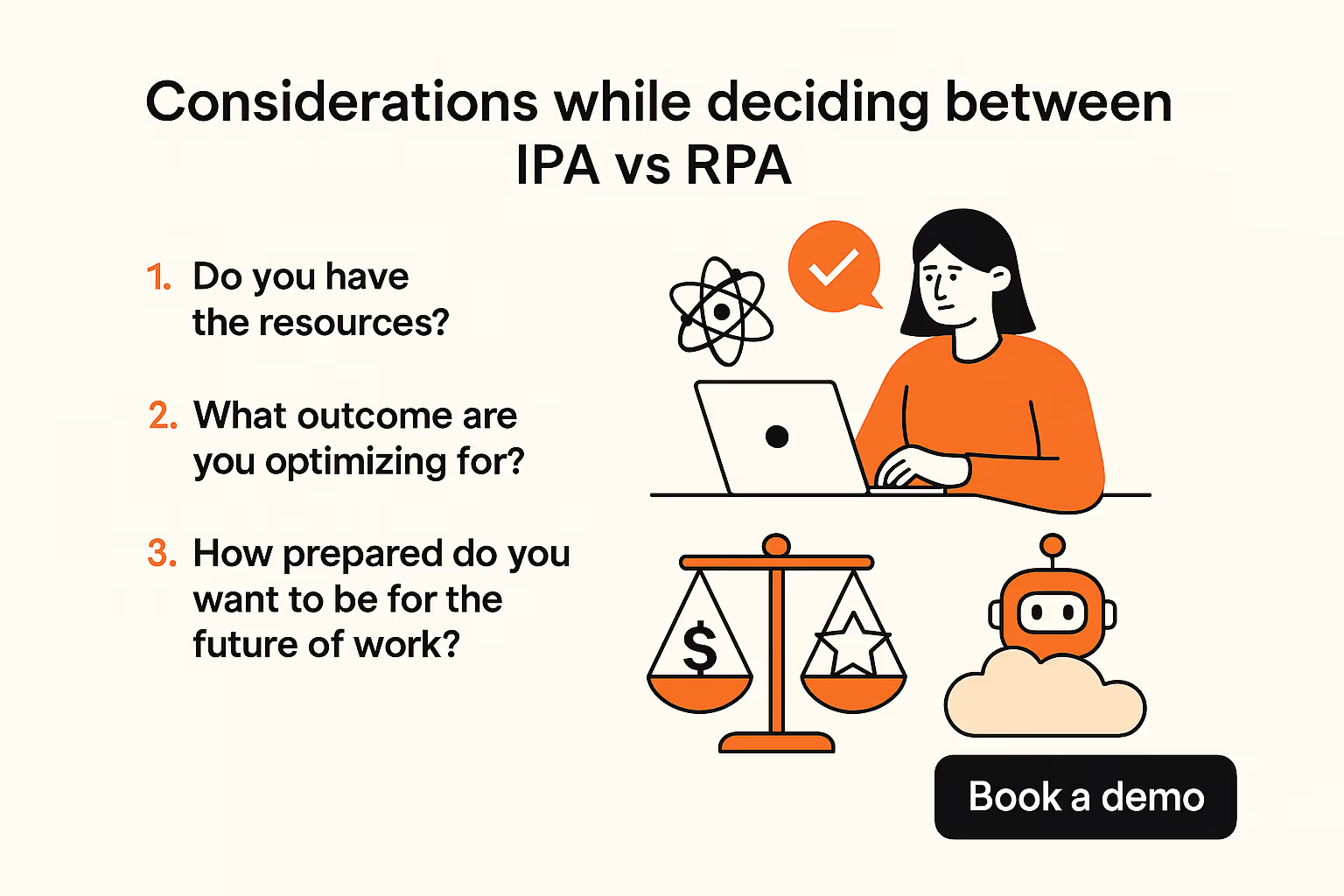
1. Do you have the resources?
Adopting IPA might require stronger technical expertise—data scientists, AI engineers, etc. If your team doesn’t have those yet, you might start with RPA and gradually build up.
Alternatively, you can partner with 5X. 5X is a next-generation data and AI platform that not only automates tasks but also integrates all your data and systems, giving the automation full context. Unlike a generic RPA tool that might operate in a silo, 5X’s platform comes with a unified data backbone and AI capabilities built in. That means you don’t have to bolt on intelligence later ; it’s there when you need it.
Businesses using 5X can orchestrate complex workflows that span departments, with real-time data and AI-driven decisions as part of the flow. In essence, 5X aims to transcend the limitations of RPA by delivering automation that’s adaptable and informed by your business’s data.
2. What outcome are you optimizing for?
If it’s purely cost reduction on an existing process, RPA can do that nicely. If it’s also about improving the process outcome (not just doing it cheaper, but doing it better), IPA has more to offer.
For example, RPA will get a repetitive task done faster/cheaper, but it won’t improve quality or yield by itself. IPA might actually produce better decisions, e.g., an AI might approve more good customers and deny fraudulent ones more accurately than a manual process, thereby improving revenue or reducing losses.
3. How prepared do you want to be for the future of work?
Technologies like AI are advancing quickly. By choosing IPA early, you inherently build a capability in your organization for AI-driven operations, which could be a competitive advantage. On the other hand, if you’re not ready culturally or technically for AI yet, RPA can deliver value now and you can deal with AI later.
The future of automation is data-driven
The key takeaway is that while RPA can dramatically improve efficiency for repetitive tasks, it has its limits in a world of constantly evolving business needs. IPA is the path to transcending those limits, allowing end-to-end processes to run autonomously and intelligently. Companies that adopted RPA are already seeing the need to infuse intelligence as they scale. Otherwise, they end up managing an army of bots that can’t handle exceptions.
On the other hand, organizations that invest in IPA early often find they can leapfrog competitors by delivering faster service, better quality, and more innovative workflows that simply weren’t possible before.
It’s also clear that data is the fuel for IPA. By integrating automation with your broader data strategy (and even your AI and analytics strategy), you unlock the real power of intelligent automation.
This is where 5X stands out: it’s not just about deploying bots, but about creating a data-driven automation fabric for your company. When your automation is plugged into all your data sources—CRM, ERP, databases, third-party APIs—it gains context and can make informed decisions. That’s something rigid RPA scripts isolated on a desktop could never do.
FAQs
What are the main challenges when moving from RPA to intelligent automation?

How do regulatory and compliance issues differ between RPA and intelligent automation?

How do RPA and IPA work together?

Building a data platform doesn’t have to be hectic. Spending over four months and 20% dev time just to set up your data platform is ridiculous. Make 5X your data partner with faster setups, lower upfront costs, and 0% dev time. Let your data engineering team focus on actioning insights, not building infrastructure ;)
Book a free consultationHere are some next steps you can take:
- Want to see it in action? Request a free demo.
- Want more guidance on using Preset via 5X? Explore our Help Docs.
- Ready to consolidate your data pipeline? Chat with us now.

How retail leaders unlock hidden profits and 10% margins
Retailers are sitting on untapped profit opportunities—through pricing, inventory, and procurement. Find out how to uncover these hidden gains in our free webinar.
Save your spot






%201.svg)
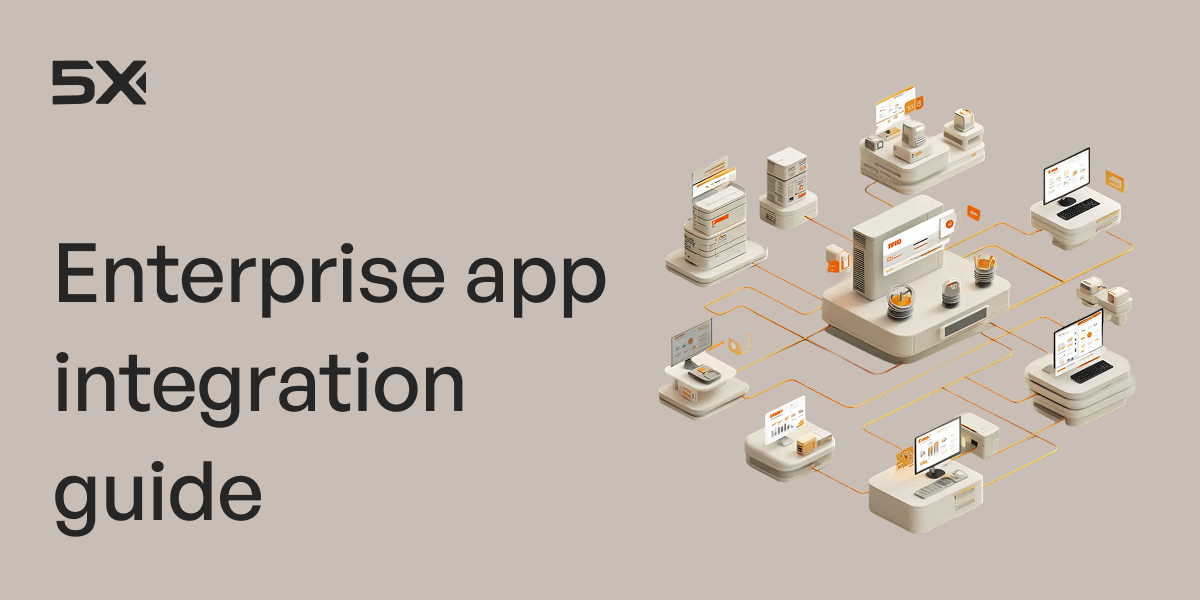
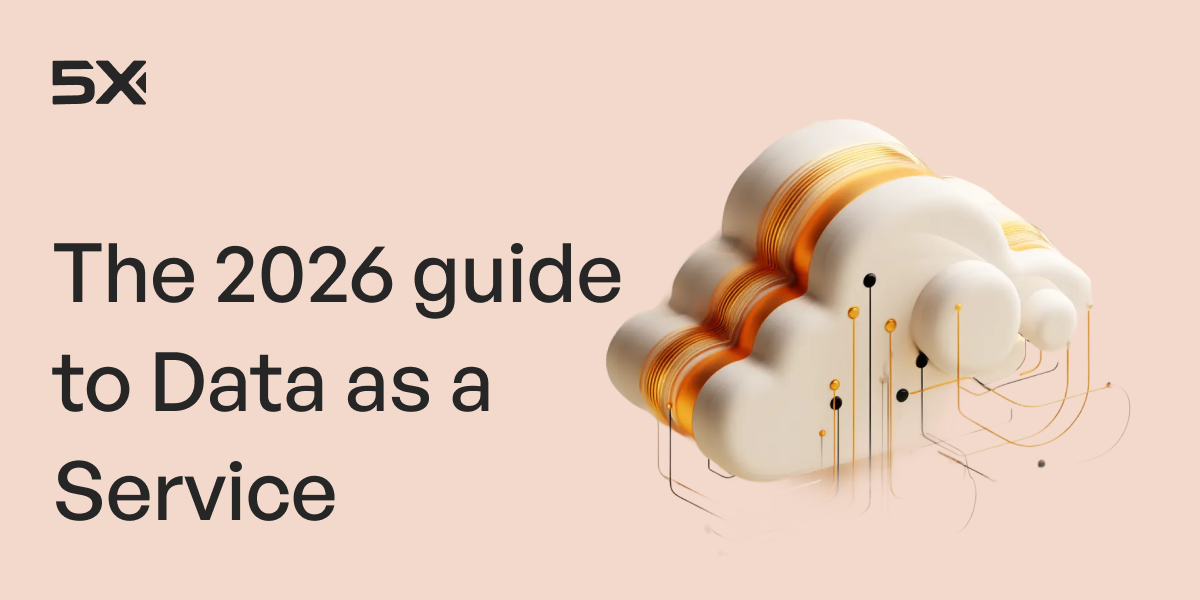
.png)






